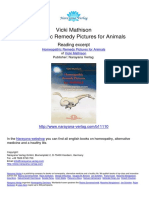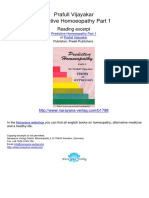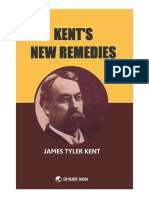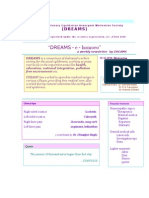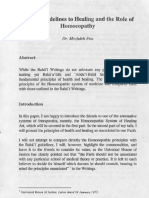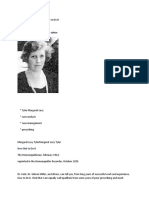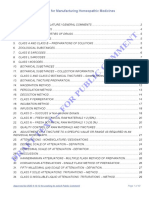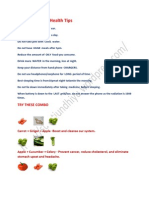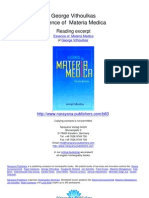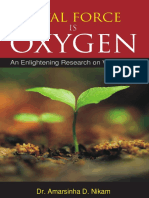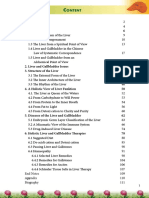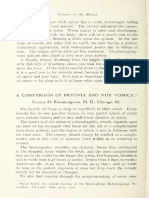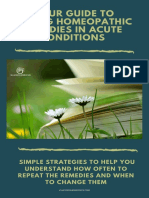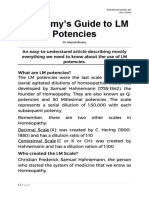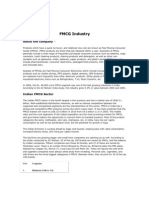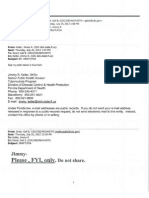Specifics in Hom (Eopathy
Specifics in Hom (Eopathy
Uploaded by
Sohail LatifCopyright:
Available Formats
Specifics in Hom (Eopathy
Specifics in Hom (Eopathy
Uploaded by
Sohail LatifOriginal Description:
Original Title
Copyright
Available Formats
Share this document
Did you find this document useful?
Is this content inappropriate?
Copyright:
Available Formats
Specifics in Hom (Eopathy
Specifics in Hom (Eopathy
Uploaded by
Sohail LatifCopyright:
Available Formats
THE BRITISH ItOM(EOFATIIIC JOURNAL 85
" SPECIFICS " IN HOM(EOPATHY
B y DR. H. HENDERSON PATRICK
THE E d i t o r has a s k e d me for a s h o r t article on " Specifics " in H o m c c o p a t h y .
Sir J o h n Weir, in a recent address to t h e F a c u l t y o f H o m c e o p a t h y , drew our
a t t e n t i o n to the work of t h e All Union I n s t i t u t e for E x p e r i m e n t a l Medicine o f
l~ussia. The first conclusion of this body, carryin~ on research work into t h e
cause of disease, is as follows : " There is no panacea. T h a t is, there is no d r u g
or medicinal f o r m u l a of a n y k i n d which is u n i v e r s a l l y c u r a t i v e either in a general
sense or in a p a r t i c u l a r disease." H a h n e m a n n t o l d us the same thing 150 y e a r s
ago. E v e r y good homceopathist knows it to be true. How, then, can we
s p e a k of " specifics " in H o m c e o p a t h y ? The t r u t h is t h a t while no r e m e d y is
or ever can be l()0 per cent. a c c u r a t e in all cases of a p a r t i c u l a r disease or
condition, in a few diseases or conditions the disease s y n d r o m e so a c c u r a t e l y
fits a k n o w n drug picture t h a t it is o n l y in a small percentage of cases we require
to go p a s t this r e m e d y . I t is little wonder, then, t h a t t h e disease a n d t h e
r e m e d y get so i n t i m a t e l y associated in t h e m i n d of the p h y s i c i a n t h a t he is a p t
to t h i n k of t h e r e m e d y as specific. The most t y p i c a l e x a m p l e of this is scarlet
fever a n d belladonna. B e l l a d o n n a poisoning a n d scarlet fever are n o t easily
distinguished, hence we find t h a t Belladonna will cut short t h e g r e a t m a j o r i t y
of cases of scarlet fever. We need n o t e x p e c t it to cure t h e m a l i g n a n t case,
b u t how often do these occur ? I can r e m e m b e r only one. This one, with a
w i d e s p r e a d m a r k e d l y hsemorrhagic rash, m a d e a good recovery u n d e r Lache~vis.
A n o t h e r e x a m p l e of the same k i n d is found in the relationship of whooping
cough a n d Drosera although, so far as m y experience goes, t h e p e r c e n t a g e o f
cases requiring Drosera is n o t so high as the p e r c e n t a g e of scarlet fever cases
requiring Belladonna.
As t h e r e m e d y for the relief of a c c i d e n t a l d a m a g e to the soft tissues Arnica
s t a n d s o u t a t a l m o s t 100 per cent. I t is n a t u r a l t h a t t h e p e r c e n t a g e here
should be high, as we are n o t dealing with a disease in t h e t r u e sense a n d no
o t h e r r e m e d y need be considered. Arnica m a y be a d m i n i s t e r e d either inter-
n a l l y or e x t e r n a l l y . I n m y opinion t h e former is more efficacious. W e find
one r e m e d y s t a n d i n g o u t also for t h e effects of accident in the psychological
sense. Ignatia is n e a r l y always the r e m e d y for t h e shock following u n e x p e c t e d
b a d news in p r e v i o u s l y h e a l t h y persons.
I n Lac caninum we have a r e m e d y which is a l m o s t specific for d r y i n g off
the secretion of milk in women who, for a n y reason, wish to s t o p feeding t h e i r
infants before the usual time.
Acne, I used to find one of the m o s t t r o u b l e s o m e things to t r e a t ; m o s t
p a t i e n t s suffering from this c o m p l a i n t were so c o m p l e t e l y void of a n y s y m p t o m s
on which to base a prescription. W h e n one finds c o n s t i t u t i o n a l s y m p t o m s
these m u s t , o f course, guide to t h e prescription. W h e n t h e r e are no s y m p t o m s
give S.S.C. I u s u a l l y s t a r t with a v e r y low potency, 6x trit., give it t.i.d, for
t h r e e days, t h e n wait. Very few cases will n o t respond.
Consideration of " specific " remedies leads on n a t u r a l l y to the question of
p r o p h y l a x i s . I n a l e t t e r w r i t t e n r e c e n t l y b y the B.M.A. to the F a c u l t y o f
H o m c e o p a t h y the s t a t e m e n t was m a d e t h a t P r e v e n t i v e Medicine was t h e
medicine of the future. The inference behind t h e s t a t e m e n t seemed to m e to
be t h a t P r e v e n t i v e Medicine was m o r e or less a m o n o p o l y of the o r t h o d o x school
a n d h a d n o t h i n g to do with H o m o e o p a t h y . E x a c t l y the opposite is t h e case.
Surely t h e homceopathist whose life work is t h e d e v e l o p m e n t of his p a t i e n t ' s
i m m u n i t y b o t h in h e a l t h a n d disease should be in a b e t t e r position t h a n his
o r t h o d o x b r o t h e r to practice P r e v e n t i v e M e d i c i n c ! Are n o t p r o p h y l a x i s a n d
t h e d e v e l o p m e n t of i m m u n i t y one a n d t h e s a m e thing .~ P r e v e n t i o n is b e t t e r
t h a n cure. I t is also easier ; easier because it m u s t , of necessity, be routine.
T h e e x a c t s y m p t o m complex which a n y o n e will develop a f t e r infection by a
86 THE BRITISH IIOMO]OPATHIC JOURNAL
particular disease virus can never be foretold with any degree of accuracy,
hence we must use for the stimulation of immunity the drug which produces
the most likely ones.
Tuberculosis in young children. This, I think, is not so common as it
used to be, but is still much more frequent than it ought to be. I shall never
forget one case which occurred in m y practice many years ago. The father of
the child was one of the earliest producers of Certified M_ilk and possessed a herd
of cattle of which he had every reason to be proud. Tile boy was brought up
under ideal conditions, had never been off the farm and had never had a day's
illness. When about three years old he was taken for a few days with his
parents to stay with friends in another part of the country. A very short time
after that he became ill, developed T.B. meningitis of which he died. I think
all children should be given Tub. bov. 12 or 30 on at least two occasions before
they are exposed to raw- milk. Some may say, of course, that the remedy is to
pasteurize the milk. I don't agree, but this is not the time to argue the point.
Smallpox. I am afraid I may bc on thorny ground here also when I say
I do not believe in the efficacy of cowpox vaccination as a prophylactic. Apart
from that it is sometimes definitely harmful and may even be the cause of death.
Variolinum is the natural prophylactic. It certainly has two advantages over
cowpox. It has a definite relationship to smallpox and it is not harmful.
l)uring the last two outbreaks of smallpox in Glasgow- many thousands of people
took Variolinum instead of being vaccinated. None of these took smallpox.
I am aware, of course, that the total number of cases was not large enough to
put much stress on this, but the fact should be noted all the same, and also the
fact that many of the people who did take smallpox had been recently vaccin-
ated.
Sea sickness. Tabacum is probably the drug with symptoms most like
this distressing condition. A dose of the 30th potency every few hours the day
before sailing will usually prove helpful.
Exam. funk or undue anxiety before public speaking, etc., can best be
prevented by one of two remedies, Arg. nit. or Gelsemium. The experienced
physician will be able to tell which of these is the better in any particular
individual.
Surgery opens a wide field for homeopathic prophylaxis. Phos. 30 given
the day before the operation will prevent the sickness which commonly follow,s
the administration of chloroform. Properly given, chloroform is not a danger-
ous anaesthetic. Practically nothing else was used for general anaesthesia in the
Glasgow Homceopathic Hospital for thirty years. There was one death out
o f over 5,000 cases. Where ether is the anaesthetic give Ant. tart. To promote
rapid healing of wounds use Calendula during the operation. Apply to any
tissue where rapid healing is desired, e.g. bowel anastomosis ; about 20 minims
o f the mother tincture to a pint of water is strong enough. After the operation
the prophylactic remedy should bc given at once. Anticipate the symptoms
and get the remedy in first. After the ordinary abdominal operation, e.g.
simple appendix, give Rhus fox. I m . or Arnica. I f the appendix has ruptured
and one is afraid of a septic spread give Pyrogen. After septic conditions
involving the liver, Crotalus. After amputations, circumcision, removal of
nails, Hypericum. After tonsillectomy the remedy is Calendula either in
potency or as a gargle or both.
I t cannot bc claimed, of course, that, using those remedies as prophylactics,
one will never get any post-operative trouble, but I think it can be said with
confidence that those troubles will be reduced to a minimum.
After punctured wounds, don't rush for antitetanic serum. Give a few
(loses of Ledum 30 and you will have no cause for worry.
You might also like
- Classical Homeopathy for Anxiety & JealousyFrom EverandClassical Homeopathy for Anxiety & JealousyRating: 5 out of 5 stars5/5 (1)
- Kushal and Kalyan Banerjee - California Presentation - May 10 Cleaned PDFDocument22 pagesKushal and Kalyan Banerjee - California Presentation - May 10 Cleaned PDFmarkosNo ratings yet
- Margaret Roy A First Materia Medica For Homoeopathy: Reading ExcerptDocument7 pagesMargaret Roy A First Materia Medica For Homoeopathy: Reading ExcerptSohail LatifNo ratings yet
- Erik Van Woensel Classical Homeopathy Evidence Based Medicine Vol. 2Document23 pagesErik Van Woensel Classical Homeopathy Evidence Based Medicine Vol. 2Sohail Latif50% (2)
- Vicki Mathison Homeopathic Remedy Pictures For Animals: Reading ExcerptDocument10 pagesVicki Mathison Homeopathic Remedy Pictures For Animals: Reading ExcerptSohail LatifNo ratings yet
- Form 2a. NTP Lab Request and Result FormDocument1 pageForm 2a. NTP Lab Request and Result FormVenusRoseRamos67% (3)
- Rife Royal Raymond - History of The Development of A Successful Treatment For Cancer and Other Virus, Bacteria and FungiDocument8 pagesRife Royal Raymond - History of The Development of A Successful Treatment For Cancer and Other Virus, Bacteria and Fungitiennos100% (2)
- Revised National Tuberculosis Control ProgrammeDocument31 pagesRevised National Tuberculosis Control Programmeprincess 4100% (3)
- DIFFERENT WAYS of FINDING THE REMEDYDocument16 pagesDIFFERENT WAYS of FINDING THE REMEDYPraveenNo ratings yet
- Nash Leaders in TyphoidDocument25 pagesNash Leaders in TyphoidhompatNo ratings yet
- A Guide To Organon of Medicine - M.N. DasDocument103 pagesA Guide To Organon of Medicine - M.N. Dastixom54521No ratings yet
- Comparative Materia Medica Ernest Albert Farrington.00034 - 1contentsDocument4 pagesComparative Materia Medica Ernest Albert Farrington.00034 - 1contentsGuido Gerardo Aguilar Barquero0% (2)
- Lectures On Organon of MedicineDocument10 pagesLectures On Organon of MedicineHomeoDr Babar AminNo ratings yet
- Nmchwdari Materia MedicaDocument27 pagesNmchwdari Materia MedicaTakpire DrMadhukar100% (1)
- Scientific Explanation of HomoeopathyDocument7 pagesScientific Explanation of HomoeopathyRehan AnisNo ratings yet
- Boenniinghausen: Minding The MindDocument4 pagesBoenniinghausen: Minding The MindProf. Dr. Kamlesh Mehta100% (1)
- Bhms HomoeopathyDocument74 pagesBhms Homoeopathyprince19000% (1)
- DR J T Kent and Kent's Repertory - A Detailed Study - Homeopathy Resource PDFDocument24 pagesDR J T Kent and Kent's Repertory - A Detailed Study - Homeopathy Resource PDFBikash Ahmed100% (2)
- Lesser Writing BogerDocument51 pagesLesser Writing BogerAtit Sheth100% (1)
- MiasmeleDocument103 pagesMiasmelemihaipopescu0No ratings yet
- Homoeo LecturesDocument49 pagesHomoeo LecturesIqbal HussainNo ratings yet
- Suppression PDFDocument9 pagesSuppression PDFDharmishtha valaNo ratings yet
- Pregnancy Ailments and Homeopathy - 2Document4 pagesPregnancy Ailments and Homeopathy - 2Anand GuptaNo ratings yet
- A Study of Hahnemanns Organon of Medicine 9788131903308Document32 pagesA Study of Hahnemanns Organon of Medicine 9788131903308Harish Sawkar100% (1)
- Prafull Vijayakar Predictive Homoeopathy Part 1: Reading ExcerptDocument5 pagesPrafull Vijayakar Predictive Homoeopathy Part 1: Reading Excerpthydroform_hydro3623No ratings yet
- Homoeopathy The Complete Handbook K P S Dhama.05772 - 2prefaceDocument4 pagesHomoeopathy The Complete Handbook K P S Dhama.05772 - 2prefacekundan singh0% (1)
- Covid Saine - 58-71Document71 pagesCovid Saine - 58-71ugien100% (1)
- Dreams 1st IssueDocument3 pagesDreams 1st IssueMaya01No ratings yet
- Clinical Application of Anamnesis in Prescribing: Some Case StudiesDocument4 pagesClinical Application of Anamnesis in Prescribing: Some Case StudiesHomoeopathic Pulse100% (1)
- Kents New RemediesDocument168 pagesKents New RemediesluckyNo ratings yet
- ESSAY - Homoeopathy Vs AllopathyDocument4 pagesESSAY - Homoeopathy Vs AllopathyAbhishek TomarNo ratings yet
- Andre SaineDocument4 pagesAndre Sainebuscador0077No ratings yet
- Keynote Prescribing JournalDocument12 pagesKeynote Prescribing JournalKirti Mishra100% (1)
- Zomeo LanDocument28 pagesZomeo LanDilshad Ali SiddiquiNo ratings yet
- A Brief Overview of The Life of Samuel HahnemannDocument6 pagesA Brief Overview of The Life of Samuel HahnemannHomeoDr Babar AminNo ratings yet
- 21 Marathon Materia Medica Ebook by Dr. Amit Gohel & Team ShaDocument707 pages21 Marathon Materia Medica Ebook by Dr. Amit Gohel & Team ShaSaiujwal PasupuletiNo ratings yet
- DREAMS - e - HomoeoDocument4 pagesDREAMS - e - HomoeoMaya01No ratings yet
- Method of Triangles PreviewDocument30 pagesMethod of Triangles PreviewNidheesh RadhakrishnanNo ratings yet
- National Homoeopathy Seminar On Non Communicable Diseases - A ReportDocument3 pagesNational Homoeopathy Seminar On Non Communicable Diseases - A ReportHomoeopathic PulseNo ratings yet
- Sahya Part 6Document114 pagesSahya Part 6Homeopathy TorrentsNo ratings yet
- Beginner's Guide To Homeopathy - T.S. IyerDocument682 pagesBeginner's Guide To Homeopathy - T.S. IyerEXO-L BBH0605No ratings yet
- UntitledDocument374 pagesUntitledBiplab RoyNo ratings yet
- Homeopathy Seminar (THREE DAYS WORKSHOP ON FIRST MODULE OF PREDICTIVE HOMOEOPATHY)Document1 pageHomeopathy Seminar (THREE DAYS WORKSHOP ON FIRST MODULE OF PREDICTIVE HOMOEOPATHY)dr_karan_sethu0% (1)
- TechniquesDocument3 pagesTechniquestakne_007No ratings yet
- Homeopathy Bahai - Healing - Role - HomeopathyDocument13 pagesHomeopathy Bahai - Healing - Role - HomeopathyZara Safina KhanNo ratings yet
- HomeopathyDocument16 pagesHomeopathygregotza0% (1)
- Healings by HomeopathyDocument20 pagesHealings by HomeopathyPritulNo ratings yet
- Ramanlal P. Patel Word-Index With Rubrics of Kent's RepertoryDocument9 pagesRamanlal P. Patel Word-Index With Rubrics of Kent's Repertorynaveen kumar100% (2)
- Margaret Lucy Tyler - How Not To Do ItDocument11 pagesMargaret Lucy Tyler - How Not To Do ItPanphila100% (1)
- Paper On Brain Tumor Data PDFDocument5 pagesPaper On Brain Tumor Data PDFBarbara SarterNo ratings yet
- Fire FlyDocument10 pagesFire FlyMuralidaran SelvarajNo ratings yet
- Draft Guidelines For Manufacturing Homeopathic MedicinesDocument40 pagesDraft Guidelines For Manufacturing Homeopathic MedicinesFuente DelavidaNo ratings yet
- Very Important Health TipsDocument8 pagesVery Important Health TipsRamesh KumarNo ratings yet
- Utility of Boger's General Analysis in Zomeo Homeopathic SoftwareDocument6 pagesUtility of Boger's General Analysis in Zomeo Homeopathic SoftwareBABLU ROY50% (2)
- Borland PDFDocument9 pagesBorland PDFkamalNo ratings yet
- Essence Vithoulkas CuprinsDocument3 pagesEssence Vithoulkas CuprinsMami Destefan50% (2)
- The Significance of Past History in Homœopathic PrescribingDocument11 pagesThe Significance of Past History in Homœopathic PrescribingClangames 4No ratings yet
- Eczema - Final Thesis Edited 22.8.09Document152 pagesEczema - Final Thesis Edited 22.8.09579Rishikesh SavardekarNo ratings yet
- Homoeopathy & Hom. Prescribing - H. FarringtonDocument178 pagesHomoeopathy & Hom. Prescribing - H. FarringtonDr. Anamika mishraNo ratings yet
- Preamble Novel Homoeopathy. Homoeopathy Verified Through Genetics - HarimanDocument45 pagesPreamble Novel Homoeopathy. Homoeopathy Verified Through Genetics - HarimanAlexandre FunciaNo ratings yet
- The Key-Note System - Henry N. Guernsey, MDDocument7 pagesThe Key-Note System - Henry N. Guernsey, MDPanphilaNo ratings yet
- Oxygen Ontents - Reading - ExcerptDocument23 pagesOxygen Ontents - Reading - ExcerptBabli Lovely Nicky100% (1)
- AcuteDocument61 pagesAcuteHomeopathy Torrents100% (2)
- Key To Successful PrescribingDocument4 pagesKey To Successful PrescribingRohit KolekarNo ratings yet
- Aspects-of-Homeopathy-Ian-Watson.07907 - 2therapeutic Index PDFDocument4 pagesAspects-of-Homeopathy-Ian-Watson.07907 - 2therapeutic Index PDFSohail Latif0% (1)
- Kidneys and Bladder Basis of Self Realisation by Rosina Sonnenschmidt Reading ExtractDocument12 pagesKidneys and Bladder Basis of Self Realisation by Rosina Sonnenschmidt Reading ExtractSohail LatifNo ratings yet
- Flow Chart For Assessing Results of TreatmentDocument1 pageFlow Chart For Assessing Results of TreatmentSohail LatifNo ratings yet
- Polychrest Versus Less Frequently Used Remedy AdditDocument4 pagesPolychrest Versus Less Frequently Used Remedy AdditSohail LatifNo ratings yet
- Liver and Gallbladder Acquired Authority by Rosina Sonnenschmidt Reading ExtractDocument11 pagesLiver and Gallbladder Acquired Authority by Rosina Sonnenschmidt Reading ExtractSohail Latif100% (1)
- Ailments of Disappointed Love An Attempt To DifferenDocument5 pagesAilments of Disappointed Love An Attempt To DifferenSohail LatifNo ratings yet
- Heart and Circulation Natural Authority by Rosina Sonnenschmidt Reading ExtractDocument12 pagesHeart and Circulation Natural Authority by Rosina Sonnenschmidt Reading ExtractSohail LatifNo ratings yet
- Table of Contents: The Esalen Conferences (Vol 1 and 2) : Part - I Materia MedicaDocument1 pageTable of Contents: The Esalen Conferences (Vol 1 and 2) : Part - I Materia MedicaSohail Latif0% (1)
- Pediatric Case Taking and Prescription Live Cases Jonathan Shore.10006 - 2paper - Case - 23Document9 pagesPediatric Case Taking and Prescription Live Cases Jonathan Shore.10006 - 2paper - Case - 23Sohail LatifNo ratings yet
- Carcinosin A Clinical and Pathogenetic StudyDocument11 pagesCarcinosin A Clinical and Pathogenetic StudySohail LatifNo ratings yet
- Encyclopaedia of Homoeopathic Pharmacopoeia Edition 2002 P N Varma Indu Vaid.01807 - 1Document6 pagesEncyclopaedia of Homoeopathic Pharmacopoeia Edition 2002 P N Varma Indu Vaid.01807 - 1Sohail LatifNo ratings yet
- Classical Homeopathic Lectures Volume J Vassilis Ghegas.05414 - 1contents - AsarumDocument8 pagesClassical Homeopathic Lectures Volume J Vassilis Ghegas.05414 - 1contents - AsarumSohail LatifNo ratings yet
- A Comparison of Bryonia and Nux VomicaDocument11 pagesA Comparison of Bryonia and Nux VomicaSohail LatifNo ratings yet
- Allen Part 1Document150 pagesAllen Part 1Sohail LatifNo ratings yet
- Materials 11 00080 v2Document17 pagesMaterials 11 00080 v2Sohail LatifNo ratings yet
- Free Dosing GuideDocument8 pagesFree Dosing GuideSohail Latif100% (3)
- A Dummy Guide To LMDocument15 pagesA Dummy Guide To LMSohail LatifNo ratings yet
- Logic of Repertories J Benedict D Castro.01547 - 1Document3 pagesLogic of Repertories J Benedict D Castro.01547 - 1Sohail Latif100% (2)
- Literature Review On MDR-TBDocument5 pagesLiterature Review On MDR-TBafmzslnxmqrjom100% (1)
- Tuberculoza TB Safety - RGB - Lo - Res PDF FINAL PDFDocument172 pagesTuberculoza TB Safety - RGB - Lo - Res PDF FINAL PDFOlga BurduniucNo ratings yet
- AbstractDocument8 pagesAbstractMa Ceres P SisonNo ratings yet
- FMCG Industry: C C C CDocument13 pagesFMCG Industry: C C C CSagar DorgeNo ratings yet
- Client Care Study of A Patient With Pulmonary TuberculosisDocument36 pagesClient Care Study of A Patient With Pulmonary Tuberculosisraphael chidiebereNo ratings yet
- Pulmonary Tuberculosis: A Case Study ofDocument28 pagesPulmonary Tuberculosis: A Case Study ofDyanne BautistaNo ratings yet
- Case Study TB: Tuberculosis Was IsolatedDocument1 pageCase Study TB: Tuberculosis Was IsolatedJefriyanto BudikafaNo ratings yet
- DOTS Strategy PDFDocument17 pagesDOTS Strategy PDFDebbie MeyerNo ratings yet
- Phrasal Verbs About Health and Illness CLT Communicative Language Teaching Resources Conv 111621Document14 pagesPhrasal Verbs About Health and Illness CLT Communicative Language Teaching Resources Conv 111621LisleNo ratings yet
- Interorient Maritime Enteprises, Inc. vs. Victor M. Creer, IIIDocument5 pagesInterorient Maritime Enteprises, Inc. vs. Victor M. Creer, IIIRah-rah Tabotabo ÜNo ratings yet
- Health History and Immunization Form: University of Valley Forge - Health CenterDocument4 pagesHealth History and Immunization Form: University of Valley Forge - Health CenterBernard AmetepeNo ratings yet
- Kecamatan Megang Sakti Dalam Angka 2022Document134 pagesKecamatan Megang Sakti Dalam Angka 2022reza septian100% (1)
- Email Addressing Duval TB OutbreakDocument5 pagesEmail Addressing Duval TB OutbreakThe Florida Times-UnionNo ratings yet
- Clinical Tuberculosis - 6th Edition-2020Document469 pagesClinical Tuberculosis - 6th Edition-2020Jhonatan Mata ANo ratings yet
- Application For Admission and Residence As A Start-Up' Working On A Self-Employed BasisDocument9 pagesApplication For Admission and Residence As A Start-Up' Working On A Self-Employed BasisAmani tariqNo ratings yet
- Where can buy Practising Public Health A Guide to Examinations and Workplace Application 1st Edition Adam D M Briggs (Editor) ebook with cheap priceDocument54 pagesWhere can buy Practising Public Health A Guide to Examinations and Workplace Application 1st Edition Adam D M Briggs (Editor) ebook with cheap pricenativahamaas100% (5)
- Tuberculosis: SeminarDocument13 pagesTuberculosis: Seminarleonan.teixeiraNo ratings yet
- Vaccination Record InglesDocument1 pageVaccination Record Inglescidaparecida141977No ratings yet
- NCP CompilationDocument11 pagesNCP CompilationRene John FranciscoNo ratings yet
- Inter-Orient Maritime Enterprises, Inc. v. Creer IIIDocument10 pagesInter-Orient Maritime Enterprises, Inc. v. Creer IIIoabeljeanmoniqueNo ratings yet
- My PosterDocument1 pageMy PosterLucky HutapeaNo ratings yet
- Prof. Vijaya Lakshmi Nag CVDocument24 pagesProf. Vijaya Lakshmi Nag CVanislinek15No ratings yet
- Prevalence of Pulmonary Tuberculosis Among Suspected Patients Visiting Shenen Gibe Hospital Oromia Region, EthiopiaDocument42 pagesPrevalence of Pulmonary Tuberculosis Among Suspected Patients Visiting Shenen Gibe Hospital Oromia Region, Ethiopiamillion addisuNo ratings yet
- PTB Case StudyDocument52 pagesPTB Case StudyLucero Hyacinth50% (2)
- Hmi 2-3-24Document24 pagesHmi 2-3-24Classic BobbyNo ratings yet
- BCG Vaccination in Neonates 4.0Document27 pagesBCG Vaccination in Neonates 4.0PanJan BalNo ratings yet
- Management of Patient With Chest and Lower Respiratory Tract Disorders - 20241111 - 135121 - 0000Document129 pagesManagement of Patient With Chest and Lower Respiratory Tract Disorders - 20241111 - 135121 - 0000Ynalem C BacbagacNo ratings yet




